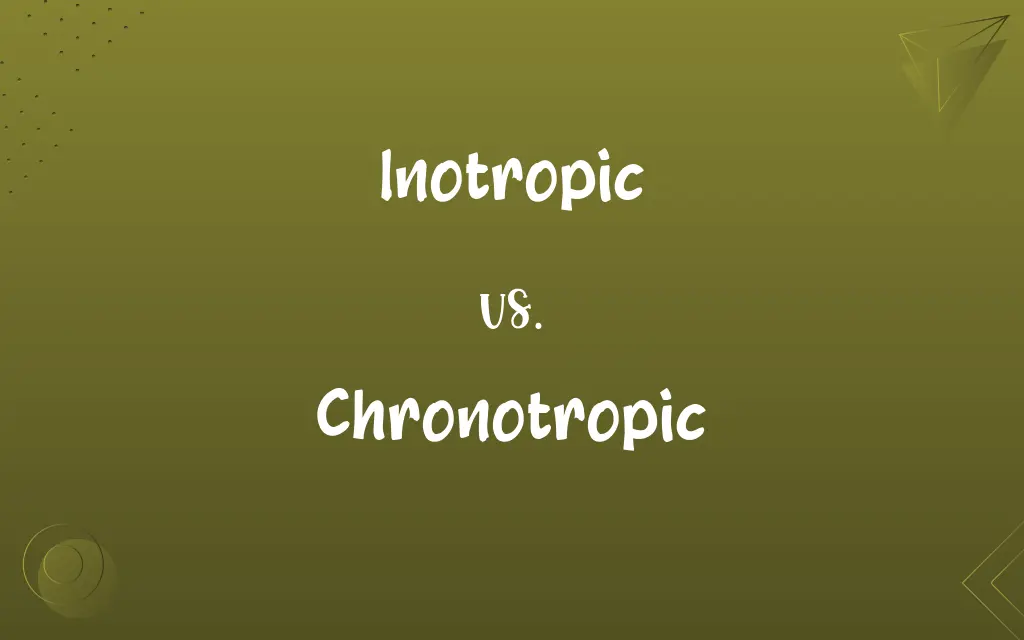Inotropic vs. Chronotropic: Know the Difference

By Hifza Nasir & Shumaila Saeed || Published on July 13, 2024
Inotropic effects relate to the force of heart contractions, enhancing or weakening them, while chronotropic effects influence the heart rate, increasing or decreasing it.

Key Differences
Inotropic agents affect the force with which the heart muscle contracts, directly impacting the heart's pumping efficiency. Positive inotropic effects increase this force, improving cardiac output, while negative inotropic effects decrease it, potentially worsening heart failure. Chronotropic effects, on the other hand, alter the heart rate: positive chronotropic agents speed it up, which can be beneficial in cases like heart block, whereas negative chronotropic agents slow it down, useful in conditions like tachycardia.
Hifza Nasir
Jul 13, 2024
The impact of inotropic effects is crucial in managing heart failure, where enhancing the heart's pumping ability can significantly improve patient outcomes. Conversely, chronotropic effects are pivotal in arrhythmias management, where normalizing heart rate can prevent complications. Both inotropic and chronotropic effects can be achieved through medication, but their specific targets within the heart's function distinguish their applications in clinical settings.
Shumaila Saeed
Jul 13, 2024
Inotropic actions are primarily mediated through changes in calcium ion concentration in heart muscle cells, influencing contraction strength. Chronotropic effects, however, are often the result of alterations in the autonomic nervous system's influence on the heart, affecting the speed of electrical impulse generation and propagation.
Hifza Nasir
Jul 13, 2024
Understanding the distinction between inotropic and chronotropic effects is essential for healthcare professionals, especially when prescribing treatments that can affect heart function. Medications can have both inotropic and chronotropic properties, but their primary effect is usually classified based on the most pronounced impact on heart function.
Shumaila Saeed
Jul 13, 2024
The balance between inotropic and chronotropic effects is critical in maintaining heart health. An imbalance can lead to cardiac dysfunctions, underscoring the importance of precise medication management to achieve the desired therapeutic effect without causing adverse outcomes.
Dua Fatima
Jul 13, 2024
ADVERTISEMENT
Comparison Chart
Mechanism of Action
Alters calcium ion concentration
Influences autonomic nervous system
Shumaila Saeed
Jul 13, 2024
ADVERTISEMENT
Inotropic and Chronotropic Definitions
Inotropic
Affecting the force of heart muscle contractions.
Digoxin has a positive inotropic effect, enhancing heart performance.
Hifza Nasir
Feb 26, 2024
Chronotropic
Pertaining to the heart rate.
Atropine exhibits positive chronotropic properties by increasing heart rate.
Shumaila Saeed
Feb 26, 2024
Inotropic
Can be positive or negative, influencing heart's pumping ability.
Beta-blockers may have a negative inotropic effect, reducing contraction strength.
Shumaila Saeed
Feb 26, 2024
Chronotropic
Used in managing arrhythmias.
Chronotropic agents are essential for correcting abnormal heart rhythms.
Dua Fatima
Feb 26, 2024
Inotropic
Impacts cardiac output.
Inotropic drugs are used to improve cardiac output in compromised hearts.
Shumaila Saeed
Feb 26, 2024
ADVERTISEMENT
Chronotropic
Influenced by the autonomic nervous system.
Chronotropic drugs affect the sympathetic and parasympathetic systems' control over heart rate.
Hifza Nasir
Feb 26, 2024
Inotropic
Involves calcium ion dynamics in heart cells.
Positive inotropes increase calcium availability, strengthening contractions.
Hifza Nasir
Feb 26, 2024
Chronotropic
Effects can be positive or negative, affecting heart rhythm.
Beta-blockers exhibit negative chronotropic effects, slowing the heart rate.
Hifza Nasir
Feb 26, 2024
Inotropic
Essential in treating heart failure.
Inotropic support is critical for severe heart failure patients.
Hifza Nasir
Feb 26, 2024
Chronotropic
Affects heart's electrical impulse generation.
Negative chronotropic agents can prevent tachycardia by slowing impulse formation.
Shumaila Saeed
Feb 26, 2024
Chronotropic
(physiology) Of, relating to, or affecting the rate of muscular contraction, especially of the heart.
Hifza Nasir
Jan 25, 2024
Inotropic
Affecting the contraction of muscle, especially heart muscle
An inotropic drug.
Hifza Nasir
Jan 25, 2024
Inotropic
(physiology) Increasing or decreasing the force of muscular contractions.
Hifza Nasir
Jan 25, 2024
Repeatedly Asked Queries
Why are inotropic agents used in heart failure?
Inotropic agents are used in heart failure to enhance the heart's pumping efficiency, improving cardiac output.
Hifza Nasir
Jul 13, 2024
What is the difference between positive and negative chronotropic effects?
Positive chronotropic effects increase heart rate, while negative effects decrease it.
Shumaila Saeed
Jul 13, 2024
What is a common clinical use for negative chronotropic agents?
Negative chronotropic agents are commonly used to treat tachycardia and other forms of arrhythmia.
Shumaila Saeed
Jul 13, 2024
How are inotropic effects measured?
Inotropic effects can be measured by assessing changes in cardiac output and contractility in response to treatment.
Hifza Nasir
Jul 13, 2024
Can adverse effects arise from inotropic or chronotropic treatments?
Yes, improper use can lead to adverse effects, emphasizing the need for careful management and monitoring.
Dua Fatima
Jul 13, 2024
How do chronotropic effects influence heart health?
Chronotropic effects influence heart health by normalizing the heart rate, either speeding it up or slowing it down as needed.
Hifza Nasir
Jul 13, 2024
What is the significance of calcium in inotropic effects?
Calcium plays a key role in muscle contraction, and its dynamics in heart cells are crucial for inotropic effects.
Hifza Nasir
Jul 13, 2024
How do healthcare providers decide between inotropic and chronotropic treatments?
Treatment decisions are based on the underlying heart condition, with the goal of optimizing heart function and patient outcomes.
Hifza Nasir
Jul 13, 2024
What does positive inotropic mean?
Positive inotropic refers to increasing the force of heart muscle contractions.
Shumaila Saeed
Jul 13, 2024
Can a drug have both inotropic and chronotropic effects?
Yes, some drugs can have both effects, but they are usually classified by their primary action on the heart.
Hifza Nasir
Jul 13, 2024
How do negative inotropic effects impact heart function?
Negative inotropic effects weaken the heart's contraction force, which can be detrimental in heart failure unless carefully managed.
Shumaila Saeed
Jul 13, 2024
What role does the autonomic nervous system play in chronotropic effects?
The autonomic nervous system regulates heart rate through sympathetic and parasympathetic inputs, affecting chronotropic actions.
Hifza Nasir
Jul 13, 2024
Are there natural ways to influence inotropic and chronotropic effects?
Lifestyle changes and exercise can influence heart health, potentially affecting inotropic and chronotropic properties naturally.
Hifza Nasir
Jul 13, 2024
Share this page
Link for your blog / website
HTML
Link to share via messenger
About Author
Written by
Hifza NasirCo-written by
Shumaila SaeedShumaila Saeed, an expert content creator with 6 years of experience, specializes in distilling complex topics into easily digestible comparisons, shining a light on the nuances that both inform and educate readers with clarity and accuracy.








































































